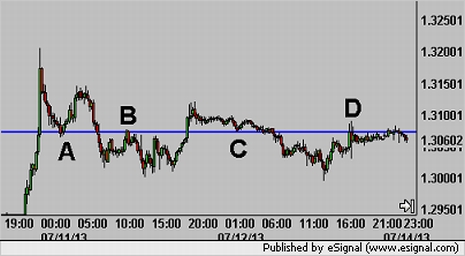 PLUS: How to Find and Trade Key Intraday Levels
PLUS: How to Find and Trade Key Intraday Levels
It was school sports day last Friday and I’m glad to say there was no sign of any “non-competing” nonsense.
The ruthless world of Seven-Year-Old athletics was on display in full glory and the kids absolutely loved it!
You could just see the determination and emotion on their faces.
At that moment, trying to win the sack race held their total focus, nothing else mattered. And whether they won, or came straggling in at the back, they all got a massive cheer as they crossed the line.
I was chatting to our accountant earlier in the week. He told me his son’s primary school had a ‘politically correct’ non-competing policy.
No child was allowed to ‘win’.
By the time he’d gone up to Grammar School, in sports – the boy was a lamb to the slaughter. A bit of healthy competition there soon got his mojo back though, he can more than hold his own in the scrum these days I’m told.
So tell today’s kids there can’t be a winner of the sack race and what message does that send? That it’s ok to not try your hardest, to just settle for a bland, middle of the road existence instead. To trundle along with no aspirations?
What do you make of that?
Without a dose of ambition and striving where do you think we’d all be?
We’d still be lounging around in caves picking the bugs out of our threadbare loincloths. Nothing wrong with that – sounds quite appealing sometimes I suppose – but it’s ambition and competitiveness that’s taken us from there to where you sit today.
But hey, I’m preaching to the converted here.
As a trader you probably know all about the ‘zero-sum game’ status of our business… for you to win, another trader has to lose (after the broker’s taken his little piece out of the middle of course – some things never change!).
And no doubt about it, trading is brutal competition of the highest order.
There was a good piece on Radio 4 last week. It was about the rise of computerised algorithmic trading in the equity (shares) markets and how it’s replacing the traders themselves. Apparently, there are only 10% of traders left on the equity desks of many firms compared to ten years ago.
All because, guess what… the traders can’t compete with the computers for speed of execution.
There was a beautiful line, something like:
“A bunch of weaklings slammed the door on the masters of the universe”
See, it’s the computer programmers who hold the keys to that particular kingdom these days. When speed became the determining factor over whether your firm made money or not or not – computer algorithms were in, and the old guard were out on their ear.
The thing is – in the equities market – rapid-fire manipulation of price and gaming the market’s perception is where the big opportunity lies. Fake orders and ‘spoofing’ go on all day long, it’s all about trying to trick other traders into making mistakes.
And there were some horrible stories.
‘Flash Crashes’ that send the value of huge corporations down to a smidgeon above zero and then bounce them back again just as quickly. It happens dozens of times a week apparently, when one of the algorithm programs goes a bit berserk!
And listen to this… the speed those computers work at in the equities these days means they can place and then remove bids – manipulating the price – faster than the speed of light can transmit the information to the eyeballs of the other market players!
So what chance did the average equities guy on Wall Street ever have of keeping his job?
It’s all about choosing your fights carefully.
You need to operate in an arena you CAN compete well in.
Luke – my eldest boy – is no slouch, but this year he couldn’t compete in the sprint against the fastest boy in his class. The egg and spoon race was a different matter though – second year in a row he’s won that (must take after his mum for eye to hand co-ordination!). It’s the arena he competes well in.
As far as our trading goes – we can leave the computer boffins to cut each other’s throats and carve-up the equities markets. We’ll mind our own business and quietly operate from the shadows at home, picking up our juicy morsels from the Forex markets. Because again, that’s the arena WE can compete well in.
In the face of algorithmic trading, don’t worry about the computer nerds coming to eat your lunch…
Here are three reasons why your choice of trading the Forex markets as a home-based trader was a smart, competitive move:
1. You’re trading the deepest, most liquid markets in existence. The algorithms are at work here, for sure. They just can’t have the same overpowering effect in Forex because of the sheer global depth of liquidity.
2. You’re under no real pressure to perform. If market conditions don’t look favorable, you can switch the screen off and go do something else. Unlike the big firms – you don’t have shareholders or clients breathing down your neck demanding results, you don’t have huge overheads to cover, and you’re not competing to keep your job.
3. Your nimble trading size means you can take advantage of tiny windows of opportunity in the clean, technically reliable environment of the Forex markets. The bigger players can’t hope to compete with you on those because of their clumsy, awkward order size.
Driven entrepreneurs and aspiring business men from generations past would have given their right-arm for the opportunity you have here, right at your feet. Your status as an independent trader gives you your personal ticket to enter one of the last true arenas of unshackled capitalism – the global currency markets.
You can listen to that BBC Radio 4 program here – A Dark Magic: The Rise of the Robot Traders.
Quick Charting Trick: Key Levels – One Man’s Floor Is Another Man’s Ceiling
This is the concept of support becoming resistance. When you’re analyzing the markets – look out for Key Price Levels that are evidently important to the market.
You’ll sometimes see the market revolve around the same price for weeks and months at a time – taking a nice trade-able bounce when it approaches that price from above or below.
You can use the level to initiate day-trades off, take a quick intraday scalp off the bounce, use it as your profit target; it can be a really helpful tool. Look out for the first re-test of the level once the market has re-established above or below it.
You’ll need to spend a little bit of time locating the levels. There’s no real short cut to this – just open your eyes and spot the repeating pattern.
Here’s a recent key level in EUR/USD – we’ll look at it on a 15-minute chart:

EURUSD 15-Minute Chart
A – This is the first sign of support as the market reverses at the 1.3073 area after that pull-back from its highs.
B – Support becomes resistance. Once the market had dipped below the 1.3073 level, it held as overhead resistance on that first re-test from below.
C – Here’s the first retest as the market re-established back above 1.3073.The bounce doesn’t look much to speak of here but it was still good for a 22 pip intraday pop to the upside.
D – This was the new retest from below once the market got back down there. Good for 40 pips to the downside off intraday entries.
So what next, will a new retest of 1.3073 hold if the market moves higher again this week? Let’s see what we get.
Be Prepared: Market moving data coming this week:(London Time – BST)
Watch out for Bernanke (or Raskin) surprising the market with any unexpected comments this week.
Wednesday 17th July:
09:30 UK Claimant Count Change (GBP)
09:30 UK BOE Monetary Policy Meeting Minutes (GBP)
15:00 US Bernanke Testifies! (USD)
19:30 US Fed member Raskin speaks (USD)
Thursday 18th July:
09:30 UK Retail Sales (GBP)
13:30 US Initial Jobless Claims (USD)
15:00 US Bernanke Testifies! (USD)
I hope you enjoyed this week’s issue. Let me know if you spot any activity around that 1.3073 level in EURUSD and until next time…
Happy Trading.

 PLUS: How to Find and Trade Key Intraday Levels
PLUS: How to Find and Trade Key Intraday Levels
I like the simplicity of the idea here, will give it a bit of a test. As for the school sports, my daughters school can’t even mark out the stagger on the relay correctly, so those on the outer lanes had no chance. What happened to 2pi * radius. She won the sprint, came last in the outer lane of the sprint relay, then got an end of year school report from her rather unfit looking teacher that marked her low on athletics!
Hi, does anyone have any real opinions about the Forex Megadroid system? All of the testimonials online just look to be affiliates.
Thanks for your insight